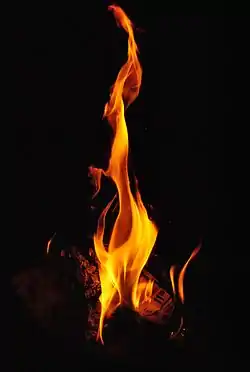< Reconstruction:Proto-Sino-Tibetan

Reconstruction:Proto-Sino-Tibetan/mej
Proto-Sino-Tibetan
Etymology
- Proto-Sino-Tibetan: *myəy ~ sməy/smyəy (Coblin, 1986)
- Proto-Tibeto-Burman: *mey (Matisoff, STEDT; Weidert, 1987; LaPolla, 1987; Benedict, 1972)
Comparing Chinese 火 with Proto-Tibeto-Burman *mey is problematic. Sagart (1999) reconstructed the Chinese word as /*m̥ˤɨjʔ/, citing its variant 𤈦 (an ancient Wu dialect word) as the basis for reconstructing a voiceless bilabial initial. This was however revised to a uvular initial in the Baxter-Sagart (2011) system, perhaps in accordance with Zhengzhang (2003). Li (1980) reconstructed it as *hwərX, and commented that it likely came from an earlier *hmərX. The word "fire" is classified by some to belong to the same family as some words meaning "to destroy", represented by 毁. Compare Written Tibetan སྨྱེ་བ (smye ba, “(archaic) damaged, impaired, poor quality”).
Confer Proto-Tai *ʰmajᶜ (“to burn (intr.)”) (Thai ไหม้ (mâi), Lao ໄໝ້ (mai)).

Fire.
Descendants
- Old Chinese:
- 火 /*qʷʰˤəjʔ/ (B-S); /*qʰʷaːlʔ/ (ZS) ("fire") (see note)
- and perhaps dialectally
- (火 in the oracle bone script)

- Middle Chinese: 火 (huɑX)
- Min
- Himalayish
- Tibeto-Kanauri
- Bodic
- Tibetan
- Written Tibetan: མེ (me, “fire, flame”)
- Tibetan
- Lepcha: ᰕᰧ (mi, “fire”)
- Bodic
- Tibeto-Kanauri
- Tangut-Qiang
- rGyalrongic
- Japhug: smi
- rGyalrongic
- Lolo-Burmese-Naxi
- Lolo-Burmese
- Burmish
- Burmese: မီး (mi:, “fire; light”)
- Loloish
- Northern Loloish
- Yi (Liangshan): ꃆꄔ (mup dut, “fire”)
- Northern Loloish
- Burmish
- Lolo-Burmese
- Karen: *hmeᴮ (Luangthongkum, 2013)
- Sgaw: မ့ၣ် (mè), မ့ၣ်အူ (mèxū, “fire”)
See also
- *bʷar ~ pʷar (“to burn, to ignite; fire”)
- *hwa-t (“to shine; light”)
- *m-t(w)əj ~ m-ti-s (“water, liquid, fluid”)
This article is issued from Wiktionary. The text is licensed under Creative Commons - Attribution - Sharealike. Additional terms may apply for the media files.
